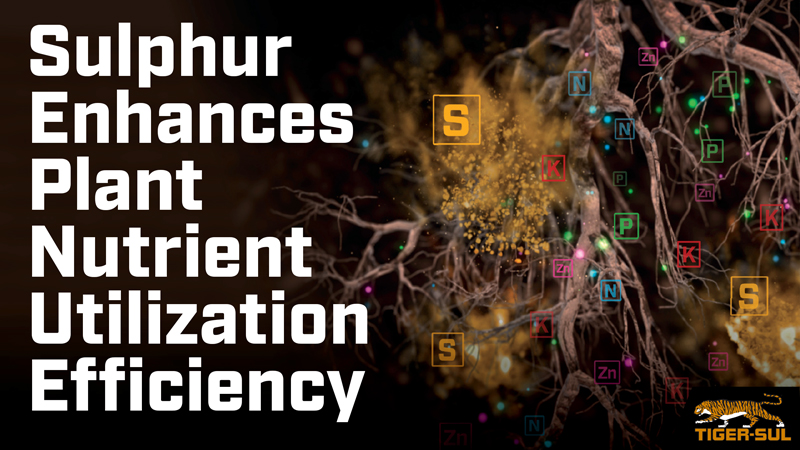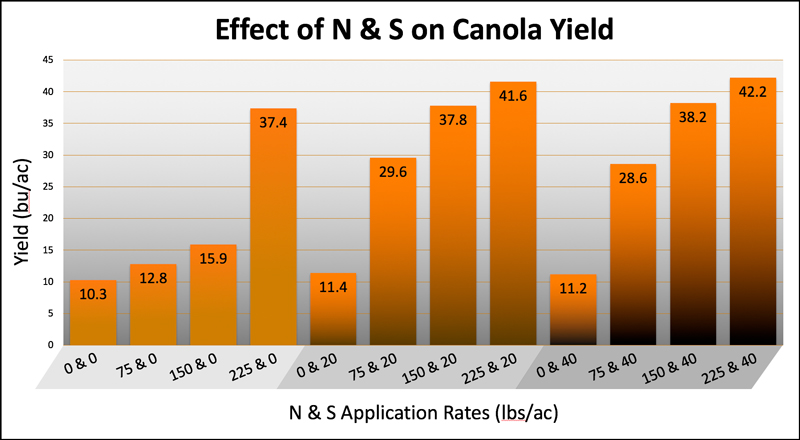Sulphur Enhances Plant Nutrient Utilization Efficiency
Sulphur Deficiency Limits Yields: Enhance Plant Nutrient Utilization Efficiency with Sulphur

Plants have the unique ability to utilize sunlight, water, and minerals to produce various food and fiber products. Farmers have accepted the responsibility to manage food or fiber producing crops and strive to enhance the opportunity for those crops to obtain optimum growth and production.
Many factors influence crop growth and yield response, including:
- plant physiology
- sunlight
- weather
- nutrients
- soil type
- pests
- genetics
Of these yield influencing factors, producers have a direct impact on plant nutrient availability to boost crop productivity. Fertilizer applications that coincide with plant nutrient uptake will enhance nutrient use efficiency and potential crop response. Optimum crop production requires a balanced supply of nutrients. Unfortunately, there are differences in plant nutrient uptake due to various loss/fixation mechanisms in the plant-soil system. Therefore, all nutrients will not be available to crops in optimum proportions at any given time. Detailed analysis of soil test reports is required to determine plant nutrient application rates. In many cases plant nutrient needs will vary within each field. Matching crop nutrient needs with current soil fertility status is challenging as there are 16 essential nutrients that must be balanced.
Research reports have demonstrated that some plant nutrients influence the uptake of other plant nutrients. An understanding of these interactions provides information for more informed nutrient management decisions. The fact that nitrogen (N) and sulphur (S) are primary components of proteins indicates that the availability of both nutrients is highly interactive. Field research has demonstrated synergistic effects on the uptake of S and N when both were applied together on corn and canola (Dev et al., 1979, Fazli et al., 2008).
Sulphur and Nitrogen Interaction
Nitrogen and sulphur influence the plant’s ability to absorb other nutrients. “Optimum nitrogen levels increased corn plants’ ability to absorb phosphorus, potassium, and sulphur. But all nutrient uptake rates are dependent on the specific interactions of corn hybrids with their environment and management factors like plant density and soil nutrient availability” (Vyn, 2013). Sulphur influences nitrogen use efficiency, yield, and seed quality in canola. Figure 1.0 reveals the influence sulphur has on canola seed yield.

Figure 1.0: Nitrogen and Sulphur interaction influence on canola yield. This trial was conducted in Montana at five locations over two years. The values are average across locations and years. – Adapted from G. Jackson, 2000
The synergism between N and S resulted in optimal canola yield with 20 lbs./ac. sulphur and 150 lbs./ac. nitrogen. There were no significant differences in yield when no N and S was applied compared to treatments with N and no S or the treatments with S and no N. One exception was the treatment that received 225 lbs./ac. N, there were no differences across all treatments at this rate. The yield was numerically higher, but was not significantly greater than the treatments that received 150 lbs. N and 20 lbs. S.
Sulphur Interactions with Phosphorus and Potassium
Sulphur and phosphorus interactions tend to be species specific probably due to differences in root morphologies and varying demands on nutrients (Abdin, 2003). Synergistic crop responses with sulphur and phosphorus (P) have been reported in corn, sorghum, canola, and wheat. There have been synergistic benefits realized with sulphur and potassium (K), as well.
Sulphur deficiency results in crop yield reductions and impairs grain quality. It is often overlooked as contributor to influencing environmental quality. In situations where sulphur is deficient nitrogen utilization is reduced such that nitrogen loss through leaching and volatilization may increase (Schnug, 1991). Generally, each pound of sulphur deficiency causes 15 pounds of nitrogen to be released into the environment (Haneklaus et al., 2008).
Including Tiger-Sul sulphur products in your nutrient management program enhances crop utilization of other plant nutrients and promotes positive environmental stewardship.
Download this technical bulletin here: https://www.tigersul.com/efficiency
References:
Abdin, M.Z. et al. 2003. Sulphur interaction with other nutrients. In Sulphur in Plants.
Abrol, Y.P., Ahmad, A. Eds.; Kluwer Academic Publishers: Dordrecht, pp. 177-188.
Dev G, Jaggi RC, Aulakh MS 1979 Study of nitrate-sulphate interaction on growth and nutrient uptake of maize using 35S. J Ind Soc Soil Sci 27: 302-307.
Fazli, I.S. et al., 2008. Interactive effect of sulphur and nitrogen on nitrogen accumulation and harvest in oilseed crops differing in nitrogen assimilation potential.
J Plant Nutri 31: 1203-1220.
Haneklaus, Silvia. 2008. “History of Sulphur Deficiency in Crops” in Sulfur: A Missing Link Between Soils, Crops, and Nutrition. J Jez, (ed.) Agonomy Monograph 50.
American Society of Agronomy, Madison, Wis.
Jackson, G. 2000. Effects of Nitrogen and Sulfur on Canola Yield and Nutrient Uptake.
Agron. J. 92:644–649
Schnug, E. 1991. Sulphur Nutrition Status of European Crops and Consequences for
Agriculture. Sulphur Agric. 15:7-12.
Vyn, Tony. 2013. Nitrogen key to uptake of other corn nutrients. In Purdue Today. Purdu